
Rioja is a wine region in Spain, with denominación de origen calificada. Rioja wine is made from grapes grown in the autonomous communities of La Rioja and Navarre, and the Basque province of Álava. Rioja is further subdivided into three zones: Rioja Alta, Rioja Oriental and Rioja Alavesa. Many wines have traditionally blended fruit from all three regions, though there is a slow growth in single-zone wines.

Sparkling wine is a wine with significant levels of carbon dioxide in it, making it fizzy. While it is common to refer to this as champagne, European Union countries legally reserve that word for products exclusively produced in the Champagne region of France. Sparkling wine is usually either white or rosé, but there are examples of red sparkling wines such as the Italian Brachetto, Bonarda and Lambrusco, and the Australian sparkling Shiraz. The sweetness of sparkling wine can range from very dry brut styles to sweeter doux varieties.
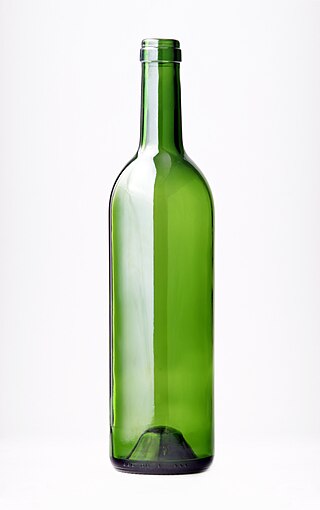
A bottle is a narrow-necked container made of an impermeable material in various shapes and sizes that stores and transports liquids. Its mouth, at the bottling line, can be sealed with an internal stopper, an external bottle cap, a closure, or induction sealing.

Solera is a process for aging liquids such as wine, beer, vinegar, and brandy, by fractional blending in such a way that the finished product is a mixture of ages, with the average age gradually increasing as the process continues over many years. The purpose of this labor-intensive process is the maintenance of a reliable style and quality of the beverage over time. Solera means "on the ground" in Spanish, and it refers to the lower level of the set of barrels or other containers used in the process; the liquid is traditionally transferred from barrel to barrel, top to bottom, the oldest mixtures being in the barrel right "on the ground". The containers in today's process are not necessarily stacked physically in this way but merely carefully labeled. Products which are often solera aged include Sherry, Madeira, Lillet, Marsala, Mavrodafni, Muscat, and Muscadelle wines; Balsamic, Commandaria, some Vins doux naturels, and Sherry vinegars; Brandy de Jerez; beer; rums; and whiskies. Since the origin of this process is the Iberian peninsula, most of the traditional terminology is in Spanish and Portuguese.

Winemaking, wine-making, or vinification is the production of wine, starting with the selection of the fruit, its fermentation into alcohol, and the bottling of the finished liquid. The history of wine-making stretches over millennia. There is evidence that suggests that the earliest wine production took place in Georgia and Iran around 6000 to 5000 B.C. The science of wine and winemaking is known as oenology. A winemaker may also be called a vintner. The growing of grapes is viticulture and there are many varieties of grapes.

Red wine is a type of wine made from dark-colored grape varieties - The color of the wine can range from intense violet, typical of young wines, through to brick red for mature wines and brown for older red wines. The juice from most purple grapes is greenish-white, the red color coming from anthocyan pigments present in the skin of the grape. Much of the red wine production process involves extraction of color and flavor components from the grape skin.
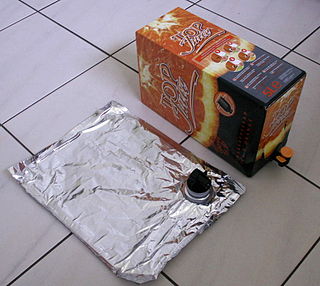
A bag-in-box or BiB is a container for the storage and transportation of liquids. It consists of a strong bladder, usually made of several layers of metallised film or other plastics, seated inside a corrugated fiberboard box. The BiB is used because of its easy transportation and ability to dispense liquids. It is mainly used in the food industry for transporting condiments and drinks, for transporting liquid chemicals, and for dispensing fertilizer for various farming practices.

A porrón is a traditional glass wine pitcher, which holds 0.75 litres (25 US fl oz) typical of Spain, originating in Catalonia, in northeastern Spain, and eventually spreading to other parts of Spain. This invention allows everyone to drink from the same utensil without touching it with their lips. It fosters communal drinking accompanying food, though it does require some skill to ensure the wine enters one's mouth and to keep it from spilling onto clothing. The porron resembles a cross between a wine bottle and a watering can. The top of the bottle is narrow and can be sealed off with a cork. Stemming upwards from the bottom of the pitcher is a spout that gradually tapers off to a small opening. It is shaped such that the wine stored inside it will have minimal contact with the air, while being ready to be used at all times. Until the mid-twentieth century it was very common in homes, but the tradition is now slowly being lost. The idea originated as a replacement to bota bags. Porrons are most commonly filled with regular wines, either white or red, but are also used to drink cava, and a smaller version filled with a sweet, dessert wine is also common in Catalan restaurants. The lack of contact with the lips allows a group of people to share the same vessel without offending their sense of hygiene.
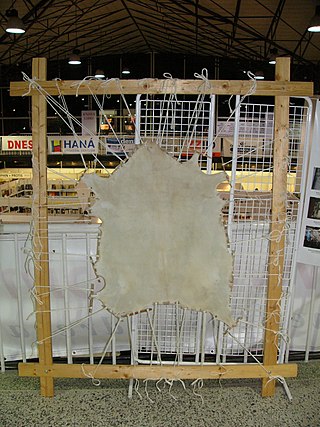
Goatskin refers to the skin of a goat, which by long term usage, is denoted by the term Morocco leather. Kidskin, used for gloves, shoes and other accessories, is traditionally goatskin, although other leathers such as sheep and kangaroo can be used to make kid.
The glossary of wine terms lists the definitions of many general terms used within the wine industry. For terms specific to viticulture, winemaking, grape varieties, and wine tasting, see the topic specific list in the "See also" section below.
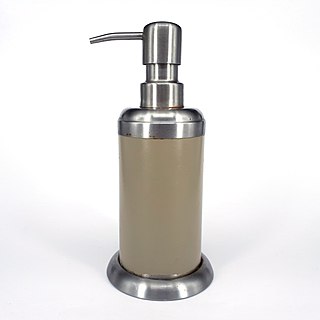
A soap dispenser is a device that, when manipulated or triggered appropriately, dispenses soap. They can be automatic or manually operated by a handle and are often found in public toilets or private bathrooms
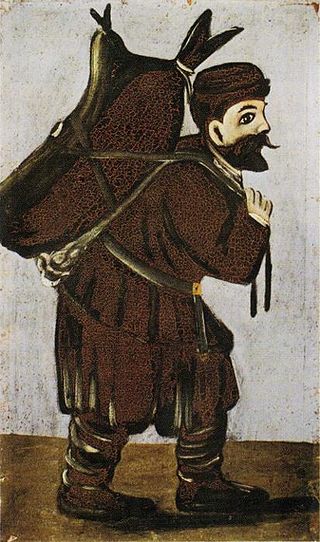
New Wine into Old Wineskins is a parable of Jesus. It is found at Matthew 9, Mark 2, and Luke 5.
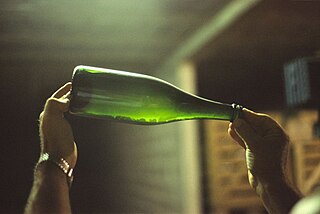
The traditional method for producing sparkling wine is the process used in the Champagne region of France to produce Champagne. It is also the method used in various French regions to produce sparkling wines, in Spain to produce cava, in Portugal to produce Espumante and in Italy to produce Franciacorta. The method is known as the méthode champenoise, but the Champagne producers have successfully lobbied the European Union to restrict the use of that term within the EU only to wines produced in Champagne. Thus, wines from elsewhere cannot use the term "méthode champenoise" on products sold in the EU, and instead the term "traditional method" or the local language equivalent. South African wines from the Western Cape are labelled with the term Methode Cap Classique. Some wine producers in countries outside the EU may disregard EU labeling laws and use méthode champenoise or even "Champagne" on labels for products not exported to the EU, but this usage is decreasing.

The Haro Wine Festival is a summer festival in the town of Haro, La Rioja, Spain. It features a Batalla de Vino and youth bullfights. It is considered a "Festival of International Tourist Interest" and, therefore, is very tourist friendly. The festival takes place on June 29, the day of the patron saint San Pedro.

A wash bottle is a squeeze bottle with a nozzle, used to rinse various pieces of laboratory glassware, such as test tubes and round bottom flasks.

A wineskin is an ancient type of bottle made of leathered animal skin, usually from goats or sheep, used to store or transport wine.
This glossary of winemaking terms lists some of terms and definitions involved in making wine, fruit wine, and mead.

A waterskin is a receptacle used to hold water. Normally made of a sheep or goat skin, it retains water naturally and therefore was very useful in desert crossings until the invention of the canteen, though waterskins are still used in some parts of the world. Though it may have been used over 5,000 years ago by tribal peoples, the first pictures of it are from ancient Assyrians, who used the bladders as floats in 3000 BCE. It also was used by large ancient empires such as Rome before the advent of the canteen.

Flexible tanks are a kind of storage equipment for liquids such as water or oil. Compared to steel tanks, flexible tanks have many advantages, including lighter weight and being rustproof, foldable, and quicker and easier to set up. With the same capacity, an empty flexible tank may have just 10% of a steel tank's weight. The disadvantages of flexible tanks include lower durability and shorter longevity. Some flexible tanks can be used as transport containers on trucks, ships, or aeroplanes, with some suitable for use in airdrops, helicopter swing, or hauling water.
A mashk is a traditional water-carrying bag, usually made of waterproofed goat-skin, from North India, Pakistan and Nepal. Mashqs can vary in size, from a hand-held bag, which was often used to carry liquids such as alcohol, to a large sized bag that comes with shoulder strap. They usually have only one narrowed opening. A person who is carrying a large mashk is called a māshqi. Traditionally, in the northern part of the South Asia, the larger mashq was associated with the Bhishti subcaste who were employed as water-carriers by all other sections of society and often seen dispensing water in public places, gardens and construction sites.

















